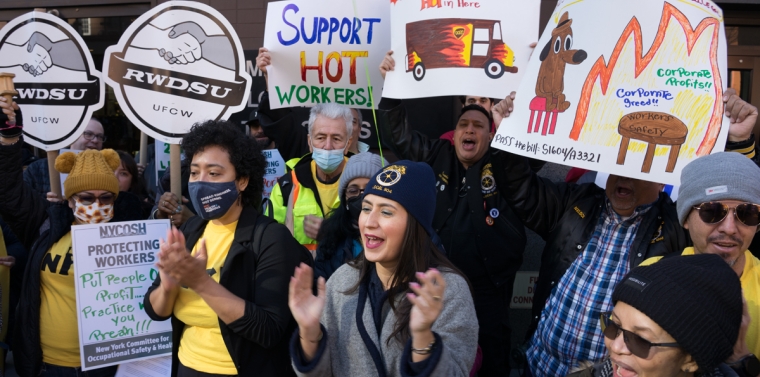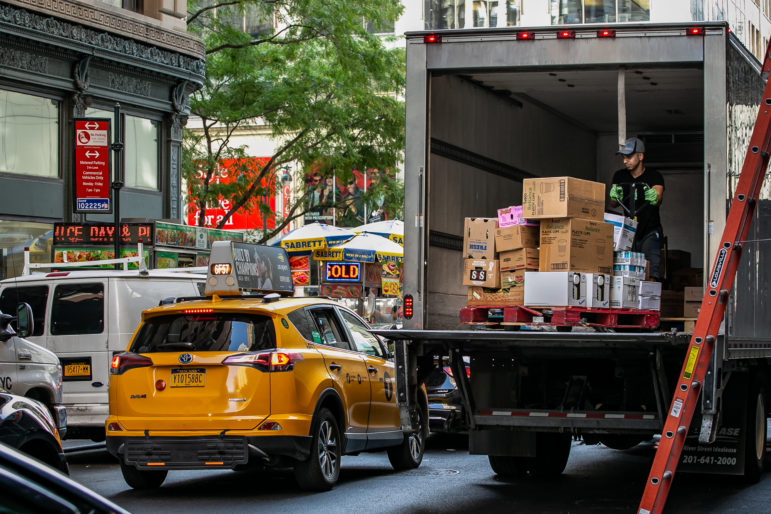Workers, especially people of color and immigrants, are suffering in increasingly hot weather. But some advocates and lawmakers have solutions.

Aidan Accornero
A street vendor in Brooklyn sought relief from the heat under an umbrella in July.This story was produced by student reporters in City Limits’ CLARIFY News program: Alana Allen, Sangeeta Chakraborty, Fatoumata Conde, Kayla Hall, Soleil Hendy, Shanyll Nunez, and former instructor Abigail Savitch-Lew. With additional reporting by Valerie Lazo, Nini Shalamberidze, Ariana Reyes, Carlos Sofge-Osorio, Aryana Stephane, Andrea Moral-Lopez and Zoë Shaw.
One late afternoon in July, after many days of humid, smoggy weather, Times Square was for once feeling cooler, with a pleasant breeze and the sun bending west.
Around that time, a security guard was almost finished with her nine-hour shift at a loading dock in the neighborhood. She recounted how difficult it had been to deal with the heat at her job: her mandatory uniform required long pants, and people stationed further inside were required to wear jackets.
“I can stand at the edge of the dock, or I can sit back there,” she gestured further into the loading bay. “But it’s too hot back there; there’s no AC or nothing.”
Extreme heat in New York City is a crisis for all, but workers—particularly those who labor in the sun or without air conditioning—are among the most impacted groups. As explained by the Centers for Disease Control and Prevention (CDC), extreme heat refers to exceptionally high temperatures that surpass the average in a specific location, posing severe health risks to inhabitants.
The increasing prevalence of extreme heat is one consequence of a warming planet: according to the New York City Panel on Climate Change, New York City is on track to see the number of days at or above 90 degrees Fahrenheit double by the 2050s.
A national report by the Union of Concerned Scientists found that if no action is taken to mitigate climate change, by midcentury, “the increased intensity, frequency, and geographic extent of extreme heat would cause a three- to fourfold increase in the exposure of outdoor workers to days with a heat index—or ‘feels like’ temperature—above 100 F, the point at which the CDC recommends that work hours begin to be reduced.”
Exposure to heat can lead to heat stress, which can result in heat stroke, heat exhaustion, heat cramps, and heat rashes. Heat can also have indirect impacts: in hot conditions, workers have slower reaction times or may have sweaty palms, fogged-up safety glasses, and dizziness, all of which can contribute to injuries on the job. Workers can also suffer burns when in contact with hot surfaces or steam. Often, heat will exacerbate pre-existing health conditions.
According to New York City data, every summer there are an estimated 450 heat-related emergency department visits, 150 heat-related hospital admissions, 350 heat-exacerbated deaths, and 10 heat-stroke deaths. This includes worker and non-worker incidents alike.
The Bureau of Labor statistics offers data on the number of work-related deaths from 2011 to 2021 as a result of exposure to environmental heat. Based on City Limits’ calculation, the national average is about 40 deaths per year.
But there is widespread concern—including from Mayor Eric Adams’ office and from the federal Office of Safety and Health Administration (OSHA)—that this is an underestimation, both because of underreporting and because the data may fail to capture indirect or delayed impacts, such as when heat impairs a worker’s reaction time, leading to injury.
Workers at risk of heat stress include outdoor workers—like those in construction, sanitation and grounds maintenance, security, farming, or transportation and delivery—as well as those in hot indoor environments such as restaurant workers, boiler room workers, and those working in factories and warehouses that are not air conditioned.
The dangers of extreme heat on workers is also a class and race issue; as a result of myriad structural factors and systemic racism, people of color and immigrants, especially undocumented immigrants, are expected to suffer from these issues disproportionately compared to their white, documented counterparts.
City Limits’ CLARIFY News interns reached out to multiple sources—including advocates, policymakers, and workers—to better understand what is being done, or should be done, to protect workers from increasingly warm weather.
Disproportionate impacts on vulnerable communities
For Cecilia Yuque, a water ice vendor on Flatbush Avenue, hot weather means a boost to business. “When it’s hotter, we sell more, there’s more customers,” Yuque told City Limits in July. But it can also lead to adverse effects, like rashes.
“Sometimes it feels like we’re allergic to the sun,” Yuque said of vending outdoors. “Either way, we need to eat, we need to pay rent…if I don’t work, there’s no money.”
Nationally, outdoor workers have up to 35 times the risk of dying from heat exposure than the general population.
And workers of color and immigrants are more likely to work outdoor jobs. About 32 percent of the United States’ population identifies as Black or Latino, but those two groups make up about 40 percent of outdoor workers.
In addition, immigrants were more likely than American-born workers to be employed in service, natural resources, construction, maintenance, production, transportation, and material moving occupations—including many jobs that are more likely to expose workers to extreme heat—while being less likely to work in management, professional, sales, office, and related occupations, according to the Bureau of Labor Statistics.
A study published in 2018 by the American Journal of Public Health found that compared to U.S. citizens, non-citizens had a higher risk of a heat-related death; this was especially true for Hispanic immigrants and immigrants aged 18-24. Among the 25 million deaths between 2005 and 2014 studied, 2.23 percent of immigrant deaths were due to heat-related causes, whereas only .02 percent of deaths for U.S. citizens were caused by the heat.

Mary Cunningham
Workers at a construction site in Brooklyn in July.In New York City, there are at least 751,600 people working outdoor jobs, not including delivery workers and street vendors, according to comments sent by the mayor’s office to OSHA. A disproportionate share of these workers are immigrants, particularly in the construction workforce: between 2015 and 2019, immigrants made up 37 percent of the city’s population but 63 percent of its construction workers.
The Center for Migration Studies estimates that between 2015 and 2019, 41 percent of New York City’s immigrant construction workforce was undocumented. Undocumented workers are over three times more likely than native-born residents to work in jobs with hazardous heat, according to the Mayor’s Office for Economic Opportunity’s Poverty Research Unit.
“A lot of our clients are working in construction, outdoors, working really long hours. We have clients who work in kitchens who are often facing a lack of ventilation and cooling and working in a hot environment,” said Corinna Svarlien, an attorney for the Workplace Justice Project at Make the Road New York. “A lot of times our clients don’t get proper breaks.”
Svarlien said that New York, like most of the country, is an “at-will state”—meaning workers can easily be fired by their bosses (barring a few types of exceptions)—making it harder for employees to speak up to ask for things like water breaks or other heat protections.
“Especially for undocumented workers who don’t have work authorization, finding work can be so difficult, and if they were to be fired, they wouldn’t have access to unemployment insurance that other workers have,” she explained.
The absence of laws on the books to specifically protect workers from heat makes it difficult to target this issue.
“OSHA has some guidelines about what employers should be doing, but there aren’t really strong legal protections or ways for workers to enforce any of those suggestions or guidelines. They can’t file a complaint with the New York State Department of Labor for not having adequate water breaks, for example,” Svarlien said.
Fear of deportation can also prevent undocumented workers from speaking up, though this year the Biden Administration created a new program aimed at protecting undocumented whistleblowers, and Svarlien said they’ve had some successes with it so far.
OSHA’s rulemaking efforts
OSHA is beginning to take action to correct this issue. In 2021, it released an ANPRM (An Advance Notice of Proposed Rulemaking) soliciting the public’s feedback on how to craft comprehensive regulations to prevent heat injury and illness.
OSHA already has programs to raise awareness about heat illness. It also has a standard that requires employers keep places of employment free from hazards likely to cause death or serious physical harm, and another that mandates they “record and report injuries and illnesses,” among other related provisions. One standard requires providing water at “sufficient amounts” and encouraging hydration on hot days.
Yet OSHA says its existing regulations are failing to protect workers from extreme heat, and that new regulations would go more in-depth.
In January, the mayor’s office weighed in in support of OSHA’s efforts to create a strong standard, saying the rules should set a variety of temperature thresholds that would trigger requirements for employers to meet, such as instituting 10 minutes in the shade for every hour of work.
The administration also called for better data collecting and analysis on heat-related impacts on workers, and for OSHA to create standards on sustainable design interventions—such as green roofs and light colored building materials—to incentivize their adoption in industrial, urban spaces.
But OSHA’s regulation could take as long as 10 years to be completed, leaving some advocates concerned that change isn’t coming fast enough.

International Brotherhood of Teamsters, JC-16
A rally in February introducing the TEMP Act, from State Senator Jessica Ramos and Assemblymember Latoya Joyner, would modify New York labor laws to manage high temperatures in indoor and outdoor worksites to reduce workers’ risks.Lawmakers fight for regulation
Responding to the need for worker protections against the heat, State Senator Jessica Ramos, serving District 13 in Queens, and Assemblymember Latoya Joyner, serving District 77 in the Bronx, introduced the Temperature Extreme Mitigation Act (TEMP Act) at the beginning of this year. This bill would modify New York labor laws to manage high temperatures in indoor and outdoor worksites to reduce workers’ risks.
The bill requires employers provide access to hydration and, at outdoor sites, shade. Employers will also be expected to allow and encourage cool-down breaks for employees and institute “personal protective equipment,” including air conditioning for warehouses and delivery vehicles, among other requirements.
“Employers do not act out of their own good will or benevolence to make sure that they are providing water, providing air conditioning, providing shade,” said Astrid Aune, senior advisor to Sen. Ramos.
That’s proven true for Ariana Rojas, who works delivering food for an app-based service. While those companies will often offer “tips and tricks” to workers on how to navigate extreme cold, heat or rainfall, “they don’t give any resources,” Rojas said. “They don’t give extra money to buy gallons of water throughout the day when it’s really hot, they don’t give extra money for a poncho when it’s raining.”
The TEMP bill has been amended three times since its introduction, and lawmakers didn’t have enough time to move it forward for a vote by the end of the last legislative session in Albany. Jamie Gilkey, chief of staff for Assemblywoman Joyner, said they remain hopeful that the bill will pass the Assembly in the coming year.
“In early June I was honored to meet with the family of Tim Barber, a Syracuse area man who lost his life due to heat exhaustion,” Joyner said in a statement emailed to City Limits, referring to a 35-year-old worker who died on the second day of his job in July 2020. “I know how important this legislation is to them and to so many other families in our state. That’s why I will continue working to secure enactment of the TEMP Act.”
Other states already have legislation on the books protecting workers from extreme heat. California passed a law in 2005 requiring employers in five outdoor industries to provide a certain amount of water and break times, along with heat illness training and signage. Legislation passed in 2016 expanded protections to indoor employees. Several more bills passed in California in 2022, including one creating an extreme heat ranking system (similar to the way hurricanes are ranked).
City Limits reached out to the Greater New York Chamber of Commerce to request a comment on the TEMP Act, but received no response by deadline. Yet it’s no secret that many employers oppose additional regulation, especially if it would require expenses like installing air conditioners.
On the other hand, employers already have something to worry about: one study found the U.S. is losing 2.5 billion work hours per year as a direct result of heat, while another study calculated an economic cost of $100 billion dollars per year. Economists believe this could be an undercount.
Another study found that while working in 90 F heat, worker productivity drops 25 percent, but when the temperatures surpass 100 F, productivity drops 75 percent. And The City recently reported that in New York City, worker compensations for injuries soar when the temperatures go up, according to their own study of claims from 2002 to 2022.
In a response to a City Limits request for comment, the mayor’s office did not specify whether or not it supports the TEMP Act, but noted that New York City has been advocating for worker safety regulations to be included in New York State’s extreme heat action plan, which is expected to be released in 2024, and that many of the initiatives included in PlaNYC, a roadmap to sustainability for the city, would also improve working conditions.
Union by union
In the absence of regulation, individual unions have been fighting to protect their workers from extreme heat.
Last summer, a number of UPS workers started collapsing on the job after suffering from heat-related illnesses. As this started to gain more media attention, the UPS Teamsters union escalated pressure on UPS to improve conditions.
The Teamsters announced this summer that they had negotiated and ratified a tentative five-year contract that includes, among other things, higher wages and air-conditioned vehicles. Starting in 2024, any newly purchased trucks must include air-conditioning, with current trucks gaining two fans and air induction vents.
While UPS union workers have reached a victory regarding their demands for the heat, other workers are still fighting the same battle. Amazon’s delivery workers, for example, are a particularly tricky case: because they technically work for third-party “delivery service partners,” they aren’t classified as Amazon employees.
Last year in California, over 80 delivery drivers and dispatchers who worked for the Amazon delivery service partner Battle Tested Strategies began organizing, eventually joining the Teamsters. In April, they negotiated a union contract to secure better wages and working conditions, including protection from heat, with the owner of Battle Tested Strategies.
Those workers, among many other complaints, said air conditioning in the cabs of their vehicles frequently broke down, and that conditions were unbearable in the unairconditioned back of the van where they spent time locating packages.
But Amazon cut off its contract with Battle Tested Strategies, prompting the union to file a complaint with the National Labor Relations Board and the drivers to launch an all-summer protest. Amazon denies that the contract termination had anything to do with union activities, saying Battle Tested Strategies was terminated for six breaches of conduct, such as by failing to pay for insurance and failing to complete vehicle safety audits.
In response to a request for comment, Amazon sent City Limits a June 2023 blog entitled, “Everything Amazon is doing to help employees and delivery drivers beat the heat this summer,” along with additional information describing policies to protect its delivery partners’ workers.
According to the blog and to Amazon’s emails to City Limits, each vehicle with the Amazon brand is air conditioned in the cab (which Amazon emphasizes is above industry standard), that vehicles with broken air conditioning are immediately taken out of service, and that drivers are provided safety training regarding heat.

Adi Talwar
A worker unloads packages from a truck in midtown Manhattan in 2019.Amazon also says it has spent $30 million to insulate vans and additional money in heat mitigation supplies such as electrolyte powder and coolers, and that ice machines are available at every delivery station. The company says it works with its delivery service contractors to adjust routes so that drivers can take breaks, and that in very high heat, they build routes with up to two hours of breaks.
Local 100 of the Transport Workers Union, which represents MTA employees across the city, includes information on its website about the warning signs of heat exhaustion and encourages its members to take frequent breaks and stay hydrated.
On July 27, while the temperature on the street level clocked in at 90 degrees, temperatures underground in the subway registered four or five degrees hotter. The MTA communicates with its employees about heat related issues, according to a spokesperson.
“All MTA operating agencies conduct 24/7 assessments to ensure safe operations, including to assess the impact of heat on rail and infrastructure,” said Spokesperson Kayla Shults via email. “MTA Emergency Management messages to all employees about weather hazards to ensure resiliency for our staff and our services.”
A. Gomez, a station agent who works in the booth at the Flatbush Avenue Brooklyn College subway station, said the heat can impact her more because of her asthma. The established rules—like having an air-conditioned break room underground—do help her and her coworkers, she said.
“The heat break is good,” Gomez said. “It doesn’t matter how many times you take them, because if you’re hot, you’re hot.”
To reach the editor behind this story, contact jeanmarie@citylimits.org.









